


THE AMERICAN WAR OF INDEPENDENCE
1775 -
THE REBELS CAPTURE BOSTON BUT LOSE NEW YORK 1776
xxxxxThe opening battles of the war, those of Lexington, Concord and Bunker Hill in 1775, gave much needed encouragement to the rebels. In addition, after an abortive attempt to capture Quebec and gain the support of the Canadians, they also succeeded in driving the British out of Boston in March 1776. In the south, however, it was another story. The British sent a large force to Long Island where they defeated the rebel commander George Washington. They then forced him out of Manhattan, trounced him at Chatterton Hill, White Plains, and chased him as he retreated southwards across New Jersey. With a depleted and irregular force, his chances of survival were slim. In December, however, the British went into winter quarters. Washington seized his chance. Crossing the Delaware River, he surprised and overwhelmed the Hessian garrison at Trenton, and then won the Battle of Princeton early in the New Year. These two victories kept the hopes of the revolutionaries alive until the tide turned in their favour later that year. There were to be further reversals but, as we shall see, rebel victories at the Battles of Saratoga in the autumn of 1777 were to provide a decisive turning point, changing the very nature of the conflict.
xxxxxAs we have seen, the three
battles which opened the American Revolution in 1775, those of Lexington, Concord and Bunker Hill, gave a
great deal of encouragement to the rebels. Their part -
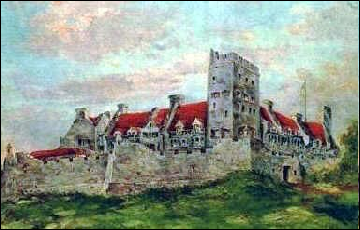 xxxxxBut even before the Battle of Bunker Hill, the colonists
had taken military action as a step towards encouraging the
Canadians to rise up in their support. In May 1775 they had attacked
and captured the Fort of Ticonderoga (illustrated) in order to
secure their route to the north. Then, later in the year, with the
support of their new commander, General Washington, an expeditionary
force was sent north via Maine in an attempt to capture Quebec and
overthrow British rule. Led by General Richard Montgomery and
Colonel Benedict Arnold it managed to reach the Canadian capital at
the end of December, but the force proved totally inadequate to
breach the city's fortifications. Montgomery was killed in the
attack, and many Americans were captured. The Canadians, having
acquired a measure of autonomy by the Quebec Act of 1774, gave
little sign of support for their cause.
xxxxxBut even before the Battle of Bunker Hill, the colonists
had taken military action as a step towards encouraging the
Canadians to rise up in their support. In May 1775 they had attacked
and captured the Fort of Ticonderoga (illustrated) in order to
secure their route to the north. Then, later in the year, with the
support of their new commander, General Washington, an expeditionary
force was sent north via Maine in an attempt to capture Quebec and
overthrow British rule. Led by General Richard Montgomery and
Colonel Benedict Arnold it managed to reach the Canadian capital at
the end of December, but the force proved totally inadequate to
breach the city's fortifications. Montgomery was killed in the
attack, and many Americans were captured. The Canadians, having
acquired a measure of autonomy by the Quebec Act of 1774, gave
little sign of support for their cause.
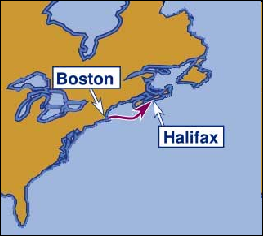 xxxxxInxMarch 1776,
however, the revolutionaries achieved one of their major aims, the capture of Boston. During the winter months, by Washington's express
orders, the cannon captured at Ticonderoga had been laboriously
brought to Boston. Mounted on the Dorchester Heights overlooking the
city -
xxxxxInxMarch 1776,
however, the revolutionaries achieved one of their major aims, the capture of Boston. During the winter months, by Washington's express
orders, the cannon captured at Ticonderoga had been laboriously
brought to Boston. Mounted on the Dorchester Heights overlooking the
city -
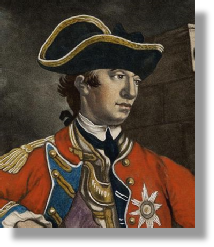
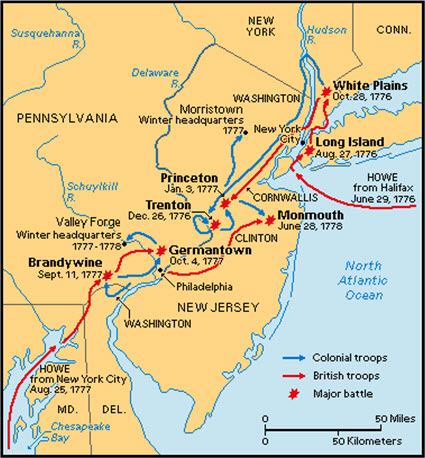 xxxxxTowards the end of August, Howe (illustrated) landed his troops on Long Island under cover of naval
gunfire. In the ensuing Battle of Long Island, Washington, who had
come south to defend New York, lost 1,000 men and was obliged to move the remnants of
his army from Brooklyn to Manhattan under cover of darkness and a
providential presence of dense fog. For the rebels, however, worse
was to come. The following month Howe invaded Manhattan and drove
Washington off the Island. Then, having caught up with and defeated
the Americans at Chatterton Hill, near White Plains, he turned back
and, in November, mounted a successful attack on Fort Washington, a
rebel garrison on Manhattan. Here, he took some 3,000 prisoners as
well as capturing guns and vital war supplies. Meanwhile, the
British General Cornwallis, having overrun the rebel garrison at
Fort Lee in November, began to drive Washington southwards across
New Jersey. With an army of little more than 4,000 men, the rebel
commander's chance of survival seemed slim indeed. "Without more
men," he wrote at this time, "the game is up".
xxxxxTowards the end of August, Howe (illustrated) landed his troops on Long Island under cover of naval
gunfire. In the ensuing Battle of Long Island, Washington, who had
come south to defend New York, lost 1,000 men and was obliged to move the remnants of
his army from Brooklyn to Manhattan under cover of darkness and a
providential presence of dense fog. For the rebels, however, worse
was to come. The following month Howe invaded Manhattan and drove
Washington off the Island. Then, having caught up with and defeated
the Americans at Chatterton Hill, near White Plains, he turned back
and, in November, mounted a successful attack on Fort Washington, a
rebel garrison on Manhattan. Here, he took some 3,000 prisoners as
well as capturing guns and vital war supplies. Meanwhile, the
British General Cornwallis, having overrun the rebel garrison at
Fort Lee in November, began to drive Washington southwards across
New Jersey. With an army of little more than 4,000 men, the rebel
commander's chance of survival seemed slim indeed. "Without more
men," he wrote at this time, "the game is up".
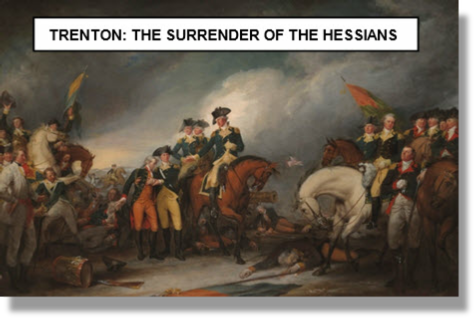 xxxxxBut true to form, General Howe did not press home the
advantage he had so clearly won. Firmly believing that the winter
was a closed season as far as fighting was concerned, he set up a
chain of winter quarters in New Jersey and returned to New York.
Cornwallis likewise was preparing to go home for a spot of leave.
Washington, on the other hand, was planning a bold and brilliant
stratagem. On Christmas night he crossed the ice-
xxxxxBut true to form, General Howe did not press home the
advantage he had so clearly won. Firmly believing that the winter
was a closed season as far as fighting was concerned, he set up a
chain of winter quarters in New Jersey and returned to New York.
Cornwallis likewise was preparing to go home for a spot of leave.
Washington, on the other hand, was planning a bold and brilliant
stratagem. On Christmas night he crossed the ice-
xxxxxThe Trenton-
Acknowledgements
Ticonderoga:
date and artist unknown. Map
(Boston/Halifax): from one.devzx.cu.cc/wp/tag/british-
G3a-


